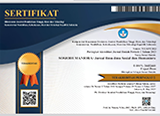ARE CONVENTIONAL RURAL BANKS MORE EFFICIENT THAN SHARIA: EMPIRICAL EVIDENCE FROM DEA
Abstract
This study examined and compared the efficiency level of conventional and Islamic rural banks. The analytical tool used was data envelopment analysis with the variable return scale approach. Furthermore, the input variables consist of total assets, third party funds, and costs. Meanwhile, the total financing and profit are the output variables from 2012 to 2019 for 15 rural banks in Aceh. The results showed conventional rural banks are more efficient than sharia. Therefore, Sharia banks need to engage in better socialization to the public. This is because 2021 is the beginning of qanun (law) of Islamic financial institutions enactment, which obliges change in shape to the sharia pattern. Also, universities are expected to open a study program on sharia bank as a rudiment for human resources in the future. Therefore, the study to compare conventional and sharia rural bank per province in Indonesia is important.
Keywords
Full Text:
PDFReferences
Almas, B., (2018). Perbandingan Efisiensi BPR Konvensional Dan BPR Syariah Provinsi Jawa Timur Dengan Pendekatan Non-Parametrik. IQTISHADIA: Jurnal Ekonomi dan Perbankan Syariah, 5(2), 188-206.
Azhari, A., (2021). Faktor-Faktor yang mempengaruhi Penyerapan Tenaga Kerja pada Sektor UMKM di Indonesia: Pendekatan Error Correction Model. Jurnal Samudra Ekonomi dan Bisnis, 12(1), 76-88.
Bismala, L. and Handayani, S., 2014. Model Manajemen UMKM Berbasis Analisis SWOT. In Prosiding Seminar Nasional PB3I ITM.
Bankers, R.D., Charnes, A. and Cooper, W.W., (1984). Some models for estimating technical and scale inefficiencies in data envelopment analysis. Management science, 30(9), 1078-1092.
Badan Pusat Statistik (2020). Statistik Indonesia. BPS. Jakarta.
Charnes, A., Cooper, W. W., & Rhodes, E. (1978). Measuring the efficiency of decision-making units. European journal of operational research, 2(6), 429-444.
Debreu, G. (1951). The coefficient of resource utilization. Econometrica: Journal of the Econometric Society, 273-292.
Farrell, M. J. (1957). The measurement of productive efficiency. Journal of the Royal Statistical Society: Series A (General), 120(3), 253-281.
Financial Services Authority. (2020). Indonesian Rural Bank Statistics. Otoritas Jasa Keuangan, Republik Indonesia.
Krisnanto, U. (2012). Faktor-faktor Yang Memengaruhi Mutu Layanan Dengan Tingkah Laku Nasabah. Jurnal Keuangan dan Perbankan, 16(3).
Kementerian Koperasi dan Usaha Kecil dan Menengah Republik Indonesia. (2019). Jumlah UMKM, investasi, tenaga kerja, Jakarta: Kementerian Koperasi dan Usaha Kecil dan Menengah Republik Indonesia
Koopmans, T. C. (1951). An Analysis of Production as an Efficient Combination of Activities. // Koopmans, T. C. (ed.) Activity Analysis of Production and Allocation. Cowles Commission for Research in Economics. Monograph. No. 13. – New York: Wiley.
Muharam, H. (2007). Analisis perbandingan efisiensi bank syariah di Indonesia dengan metode data envelopment analysis (Periode tahun 2005). Jurnal Ekonomi dan Bisnis Islam, 2(3), 80-166.
Muhari, S., & Hosen, M. N. (2014). Tingkat efisiensi BPRS di Indonesia: Perbandingan metode SFA dengan DEA dan hubungannya dengan camel. Jurnal Keuangan dan Perbankan, 18(2).
Oral, M. & R, Yolalan. (1990). An Emperical Study on Measurement Operating Ingciency and Profotability of Bank Branches. European Journal of Operational Research, 4(6), 282-94.
Peraturan Nomor 12 /POJK.03/2016 tentangKegiatan Usaha dan Wilayah Jaringan Kantor Bank Perkreditan Rakyat Berdasarkan Modal Inti.
Perbarindo. (2016). LaporanPerkumpulanPerbankan Indonesia.
Purwantoro, R. N. (2003). Penerapan Data Envelopment Analysis (DEA) Dalam Kasus Pemilihan Produk Ink Jet Personal Printer No. 10 Th. XXXII. Manajemen Usahawan, 36–41.
Prayitno, D. Perbandingan Tingkat Efisiensi BPR Konvensional Dan BPR Syariah DenganPendekatan Data Envelopment Analysis (DEA) Di Indonesia Periode 2012-2017 (Bachelor›s thesis, Jakarta: Fakultas Ekonomi Dan Bisnis UIN Syarif Hidayatullah).
Sadhana, K. (2012). Sosialisasi dan Persepsi Bank Syariah (Kajian Kebijakan Enkulturasi Nilai-Nilai Bank Syariah Dalam Masyarakat). JurnalKeuangan dan Perbankan, 16(3).
Septianto, H., & Widiharih, T. (2010). AnalisisEfisiensi Bank Perkreditan Rakyat Di Kota Semarang Dengan Pendekatan Data Envolepment Analysis. Media Statistika, 3(1), 41-48. https://doi.org/10.14710/medstat.3.1.41-48
Sutawijaya, A., & Lestari, E. P. (2009). Efisiensi Teknik Perbankan Indonesia Pasca krisis Ekonomi: Sebuah Studi Empiris Penerapan Model DEA. Jurnal Ekonomi Pembangunan: Kajian Masalah Ekonomi Dan Pembangunan, 10(1), 49. https://doi.org/10.23917/jep.v10i1.808
Wasiaturrahma, Sukmana, R., Ajija, S. R., Salama, S. C. U., & Hudaifah, A. (2020). Financial performance of rural banks in Indonesia: A two-stage DEA approach. Heliyon, 6(7), e04390. https://doi.org/10.1016/j.heliyon.2020.e04390
Welani, W., Nugraha, N., & Tanuatmodjo, H. (2016, August). An analysis of efficiency technique level of rural bank by using data
DOI: https://doi.org/10.24198/sosiohumaniora.v24i1.35546
Refbacks
- There are currently no refbacks.
Copyright (c) 2022 Sosiohumaniora

This work is licensed under a Creative Commons Attribution-ShareAlike 4.0 International License.
Sosiohumaniora Indexed By:
 Creation is distributed below Creative Commons Attribution-ShareAlike 4.0 International License.
Creation is distributed below Creative Commons Attribution-ShareAlike 4.0 International License.
Published By:
Faculty of Social and Political Sciences, Universitas Padjadjaran
Dean's Building 2nd Floor, Jalan Ir. Soekarno Km. 21 Jatinangor, Sumedang 45363
Email: jurnal.sosiohumaniorafisip@gmail.com

















